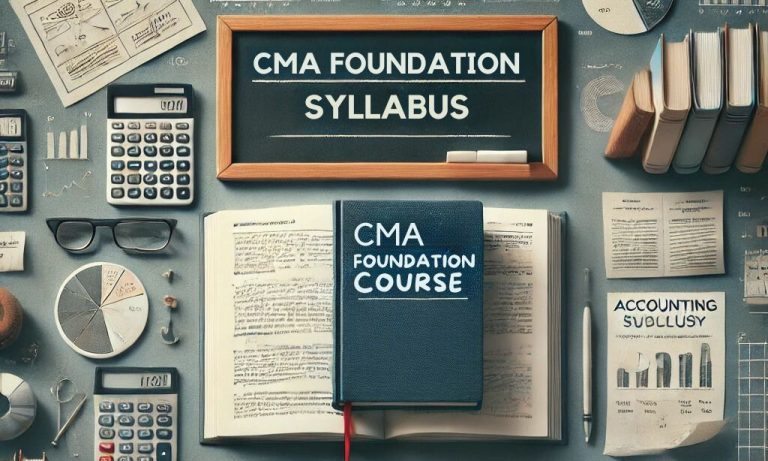The syllabus of the CMA Foundation is prescribed on the official website of the Institute of Cost Accountants of India (ICMAI). Candidates preparing for the upcoming June 2025 CMA exam should follow the syllabus. To prepare effectively for this, it is very important to understand the syllabus structure and contents in great detail. The CMA Foundation syllabus is divided into four main papers – Fundamentals of Economics and Management, Fundamentals of Accounting, Fundamentals of Laws and Ethics, and Fundamentals of Business Mathematics and Statistics. Each paper focuses on building a strong base in commerce and finance concepts, which are essential for higher levels of the CMA course. ICMAI regularly updates the syllabus to match current industry practices and ensure that students gain relevant knowledge. Knowing the detailed topics under each paper helps aspirants prioritize important sections, plan study schedules, and practice previous year’s papers accordingly.
CMA Syllabus Foundation
The CMA syllabus for Foundation level exam is specially designed to provide candidates with a sound platform for advanced studies in Cost and Management Accounting. The syllabus includes four papers, focusing mainly on accountancy, economics, laws, and mathematics. Candidates have to develop more awareness of core concepts in these subjects so that they may try to perform well in the examination and develop a very sound foundation for the intermediate and final stages of the CMA qualification.
CMA Foundation Subjects 2025
The CMA Foundation syllabus for 2025 is divide in 4 papers providing a strong foundation in accounting, business laws, and economics, essential for aspiring cost management professionals. Four subjects in the syllabus of CMA Foundation are mentioned in the table below.
| Paper | Subjects | Marks |
| Paper 1 | Fundamentals of Business Laws and Communication | 100 |
| Paper 2 | Fundamentals of Financial and Cost Accounting | 100 |
| Paper 3 | Fundamentals of Business Mathematics and Statistics | 100 |
| Paper 4 | Fundamentals of Business Economics and Management | 100 |
Detailed CMA Foundation Syllabus 2025
Here we have mentioned the detailed syllabus for CMA Foundation for Papers 1, 2, 3, and 4. Here you will get all the important topics for all subjects for the CMA Foundation exam.
If you are exploring professional finance qualifications, check out our detailed guide on What is ACCA.
Paper 1: Fundamentals of Business Laws and Communication
This section is divided into two sections: Business Laws and Communication. Check out the CMA new syllabus for Fundamentals of Business Laws and Communication for the CMA Foundation exam 2025.
| Subject | Topics | Weightage |
| Business Laws | Introduction | 10% |
| 2 Indian Contracts Act, 1872 | 30% | |
| Sale of Goods Act, 1930 | 20% | |
| Negotiable Instruments Act,1881 | 20% | |
| Business Communication | 20% | |
SECTION A: Fundamentals Of Business Laws
- Introduction
1.1 Sources of Law
1.2 Legislative Process in India
1.3 Legal Methods and Court System in India
1.4 Primary and Subordinate Legislation - Indian Contracts Act, 1872
2.1 Essential Elements of a Contract, Offer and Acceptance
2.2 Void and Voidable Agreements, No Consideration No Contract
2.3 Consideration, Legality of Object and Consideration
2.4 Capacity of Parties, Free Consent
2.5 Contingent Contracts
2.6 Performance of Contracts
2.7 Meaning of Indemnity, Guarantee, Pledge, Agent
2.8 E-Contracts and E-Signature – Meanings and Requirements
2.9 Discharge of Contracts
2.10 Breach of Contract and Remedies for Breach of Contract - Sale of Goods Act, 1930
3.1. Definition
3.2. Transfer of Ownership
3.3. Essential Conditions of a Contract of Sale
3.4. Conditions and Warranties
3.5. Performance of the Contract of Sale
3.6. Rights of Unpaid Seller - Negotiable Instruments Act, 1881
4.1. Characteristics of Negotiable Instruments
4.2. Definitions of Promissory Note, Bill of Exchange and Cheque
4.3. Difference between Promissory Note, Bill of Exchange and Cheque
4.4. Crossing – Meaning, Definition and Types of Crossing
4.5. Dishonour of Cheques (Section 138)
SECTION B: Business Communication
- Business Communication
5.1 Introduction to Business Communication
5.2 Features of Effective Business Communication
5.3 Process of Communication
5.4 Types of Business Communication
5.4.1 Formal and Informal Communication
5.4.2 Written, Verbal and Non-verbal Communication
5.4.3 Vertical, Horizontal and Diagonal Communication
5.4.4 Upward and Downward Communication
5.5 Internet-based Business Communication
5.6 Do’s and Don’ts of Communication through Social Media
5.7 Writing and Drafting for Business Audiences
5.7.1 Letter and Memorandum
5.7.2 Report – Formal and Informal
5.7.3 Business Proposal
5.7.4 Enhancement of Writing Skills
5.8 Intercultural and International Business Communication
5.9 Barriers to Business Communication
5.10 Legal Aspects of Business Communication
5.11 Use of Graphics and References for Business Communication
Paper 2: Fundamentals of Financial and Cost Accounting
This paper provides an in-depth introduction to both financial and cost accounting. Thereby, preparing students for more advanced studies at the CMA Foundation.
| Subject | Topics | Weightage |
| Financial Accounting | Accounting Fundamentals | 30% |
| Accounting for Special Transactions | 15% | |
| Preparation of Final Accounts | 25% | |
| Cost Accounting | Fundamentals of Cost Accounting | 30% |
SECTION A: FUNDAMENTALS OF FINANCIAL ACCOUNTING
- Accounting Fundamentals
1.1 Understanding of Four Frameworks of Accounting (Conceptual, Legal, Institutional and
Regulatory) and Forms of Organization
1.2 Accounting Principles, Concepts, and Conventions
1.3 Capital and Revenue Transactions – Capital and Revenue Expenditures, Capital and Revenue
Receipts
1.4 Accounting Cycle – Charts of Accounts and Codification Structure, Analysis of Transaction –
Accounting Equation, Double Entry System, Books of Original Entry, Subsidiary Books and
Finalization of Accounts
1.5 Journal (Day Books; Journal Proper – Opening, Transfer, Closing, Adjustment, and Rectification
Entries), Ledger
1.6 Cash Book, Bank Book, Petty Cash Book, Bank Reconciliation Statement
1.7 Trial Balance
1.8 Adjustment Entries and Rectification of Errors
1.9 Depreciation (Straight Line and Diminishing Balance Methods only)
1.10 Accounting Treatment of Bad Debts and Provision for Doubtful Debts - Accounting for Special Transactions
2.1 Consignment
2.2 Joint Venture
2.3 Bills of Exchange (excluding Accommodation Bill, Insolvency) - Preparation of Final Accounts
3.1 Preparation of Financial Statements of Sole Proprietorship
3.1.1 Income Statement, Balance Sheet
3.2 Preparation of Financial Statements of a Not-for-Profit Organisation
3.2.1 Preparation of Receipts and Payments Account
3.2.2 Preparation of Income and Expenditure Account
3.2.3 Preparation of Balance Sheet
CA Inter & Final Admit Card 2025
SECTION B: FUNDAMENTALS OF COST ACCOUNTING
4. Fundamentals of Cost Accounting
4.1 Meaning, Definition, Significance of Cost Accounting, its Relationship with Financial Accounting
4.2 Application of Cost Accounting for Business Decisions
4.3 Definition of Cost, Cost Centre, Cost Unit, and Cost Drivers
4.4 Classification of Costs (concerning Cost Accounting Standard 1)
4.5 Ascertainment of Cost and Preparation of Statement of Cost and Profit (Cost Sheet)
Paper 3: Fundamentals of Business Mathematics and Statistics
This paper introduces the mathematical and statistical tools necessary for business decision-making. Here is the detailed syllabus for business mathematics and statistics mentioned in the table below.
| Subject | Topics | Weightage |
| Business Mathematics | Arithmetic | 15% |
| Algebra | 20% | |
| Calculus – Application in Business | 5% | |
| Business Statistics | Statistical Representation of Data | 5% |
| Measures of Central Tendency and Dispersion | 15% | |
| Correlation and Regression | 15% | |
| Probability | 15% | |
| Index Numbers and Time Series | 10% |
SECTION A: FUNDAMENTALS OF BUSINESS MATHEMATICS
- Arithmetic
1.1 Ratios, Variations and Proportions
1.2 Time Value of Money and Annuity – Simple and Compound Interest
1.3 Arithmetic Progression and Geometric Progression
1.4 Time and Distance - Algebra
2.1 Set Theory, including Venn Diagram
2.2 Indices and Logarithms (Basic Concepts)
2.3 Permutation and Combinations (Basic Concepts)
2.4 Quadratic Equations (Basic Concepts) - Calculus – Application in Business
3.1 Concept of Calculus and its Application in Business
3.2 Revenue and Cost Function
3.3 Optimisation Techniques (Basic Concepts)
SECTION B: FUNDAMENTALS OF BUSINESS STATISTICS
- Statistical Representation of Data
4.1 Diagrammatic Representation of Data
4.2 Frequency Distribution
4.3 Graphical Representation of Frequency Distribution – Histogram, Frequency Polygon Curve,
Ogive, Pie-chart - Measures of Central Tendency and Dispersion
5.1 Mean, Median, Mode, Mean Deviation
5.2 Range, Quartiles and Quartile Deviation
5.3 Standard Deviation
5.4 Co-efficient of Variation
5.5 Karl Pearson and Bowley’s Co-efficient of Skewness - Correlation and Regression
6.1 Scatter Diagram
6.2 Karl Pearson’s Co-efficient of Correlation
6.3 Regression Analysis - Probability
7.1 Concepts and Terminologies
7.2 Primary applications of Probability Theorems - Index Numbers and Time Series
8.1 Uses of Index Numbers, Methods of Construction of Index Number
8.2 Components of Time Series and Calculation of Trend by Moving Average Method
Paper 4: Fundamentals of Business Economics and Management
This paper gives the basic issues of business economics and management: their core meaning, how these are practically implemented in the choice-making and strategies of organizations, and it sets the basis knowledge of economic theories and management in practice, giving students the grounds to approach current business problems.
| Subject | Topics | Weightage |
| Fundamentals of Business Economics | Basic Concepts | 15% |
| Forms of Market | 20% | |
| Money and Banking | 20% | |
| Economic and Business Environment | 15% | |
| Fundamentals of Management | Fundamentals of Management | 30% |
SECTION A: FUNDAMENTALS OF BUSINESS ECONOMICS
1. Basic Concepts
1.1 The Fundamentals of Economics
1.2 Utility, Wealth, Production
1.3 Theory of Demand (Meaning, Determinants of Demand, Law of Demand, Elasticity of Demand Price, Income and Cross Elasticity, Theory of Consumer Behaviour, Demand Forecasting) and Supply (Meaning, Determinants, Law of Supply and Elasticity of Supply), Equilibrium
1.4 Theory of Production (Meaning, Factors, Laws of Production – Law of Variable Proportion, Laws of Returns to Scale)
1.5 Cost of Production (Concept of Costs, Short-run and Long-run Costs, Average and Marginal Costs, Total, Fixed and Variable Costs)
1.6 Means of Production
2. Forms of Market
2.1 Pricing of Products and Services in Various Forms of Markets – Perfect Competition, Duopoly,
Oligopoly, Monopoly, Monopolistic Competition
2.2 Price Discrimination
3. Money and Banking
3.1 Money – Types, Features and Functions
3.2 Banking – Definition, Functions, Utility, Principles
3.3 Commercial Banks, Central Bank
3.4 Measures of Credit Control and Money Market
4. Economic and Business Environment
4.1 PESTEL (Political, Economic, Societal, Technological and Legal) Analysis
4.2 Emerging Dimensions of VUCAFU (Volatility, Uncertainty, Complexity, Ambiguity, Fear of
Unknown and Unprecedentedness)
SECTION B – FUNDAMENTALS OF MANAGEMENT
- Fundamentals of Management
5.1 Introduction to Management
5.2 Stewardship Theory and Agency Theory of Management
5.3 Planning, Organizing, Staffing and Leading
5.4 Communication, Co-ordination, Collaboration, Monitoring and Control
5.5 Organisation Structure, Responsibility, Accountability and Delegation of Authority
5.6 Leadership and Motivation – Concepts and Theories
5.7 Decision-making – Types and Process
Also, check out the detailed syllabus for CMA Inter examination.
CMA Foundation Exam Pattern 2025
It is also essential to know about the exam pattern of CMA Foundation along with the syllabus. This will help you to get an in-depth understanding of the types of questions and marking schemes for the CMA Foundation Syllabus
| Aspects | Details |
| Exam Mode | Offline Center Based Exam |
| Question Types | Objective Typpe Questions |
| Duration of Exam | 3 hours |
| Total Marks | 100 |
| Number of Papers | Four |
| Exam Medium | English |
| Negative Marking | No |
The syllabus of the CMA Foundation has been so designed that it lays a very sound foundation for the basic principles of business laws, corporate accounting, mathematics, statistics, economics, and management. Candidates must master these subjects to pass the subsequent stages and get good marks in the CMA course to get the Cost and Management Accountant designation. A good enough and thorough preparation of the students in these four papers will adequately equip them for a bright future in the fundamentals of cost accounting.
CMA Foundation Syllabus FAQs
What is the syllabus for CMA Foundation?
CMA Foundation syllabus is divided into four papers, i.e., Paper 1: Fundamentals of Business Laws and Communication, Paper 2: Fundamentals of Financial and Cost Accounting, Paper 3: Fundamentals of Business Mathematics and Statistics, and Paper 4: Fundamentals of Business Economics and Management.
What are the subjects covered under the CMA Foundation syllabus?
The syllabus focuses on business laws, communication, financial and cost accounting, mathematics of business, statistics, economics, and management. Each paper has its focused area to cover the student comprehensively in the aforementioned subjects.
How can I prepare effectively for the CMA Foundation exam?
Understand the syllabus properly, make a study plan, practice previous years’ CMA question papers, and always focus on conceptual clarity. One can even join coaching classes or online courses on CMA Foundation preparation, which will be quite helpful for preparations.
Is CMA Foundation difficult?
CMA Course is really a tough course, but with the hard work, dedication, and concentration you can definitely achieve it. Students preparing for the foundation examination should be familiar with the fundamentals and formulas of accounts. Revise the CMA course syllabus as much as possible because it is difficult to learn all the concepts in one revision.
Is CMA full of maths?
While the CMA program does involve some mathematics, it’s not primarily a math-intensive field. The CMA US program focuses more on financial management, accounting principles, and strategic decision-making, rather than complex calculations.
Can I complete CMA Foundation in 3 months?
In general, Part 1 requires 170 study hours, which you can cover in 10 to 13 weeks. While Part 2 takes a minimum of 130 hours of study and 8 to 11 weeks. We suggest that candidates need to study a minimum of 12 hours per week. These are good estimations on which you can base a study plan that works in your schedule.
Is CMA difficult than CA?
Generally, CA (Chartered Accountancy) is considered more difficult than CMA (Certified Management Accountant) due to the extensive syllabus, tougher exams, and longer duration of the CA course. While CMA can be completed in 3-4 years, CA typically takes around 5 years.


